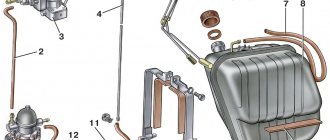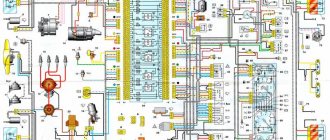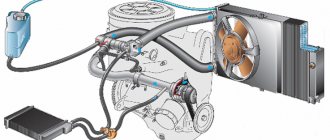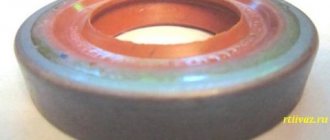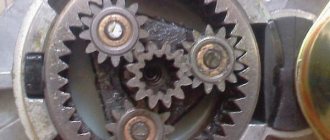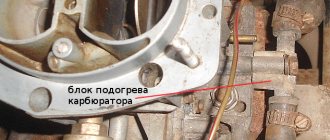A car fuel pump (fuel pump) belongs to the fuel system (fuel system) and is one of its main components. The fuel pump in a car performs the same function as the heart in the human body: it pumps, that is, pumps liquid from one place to another, only in the case of a car, fuel comes out instead of blood.
The fuel pump supplies fuel from the gas tank to the carburetor, where the air-fuel mixture is prepared. The fuel pump is a very delicate part of the fuel system and often fails or, in driving parlance, goes haywire. This is due to several reasons, first of all: poor fuel quality, dirty fuel filter, constant loads due to which natural wear of the fuel pump parts occurs, imperfect design of the VAZ 2107 product itself.
Functions and structure of the VAZ 2107 fuel pump (carburetor)
The fuel pump is a key component of the engine's fuel system. The function of the pump is to supply gasoline from the fuel tank to the carburetor bowl. The fuel pump on carburetor VAZ models is installed on the side of the cylinder block, inside the engine compartment.
The specific design of the pump makes the fuel pump one of the weak points of the fuel system. Pollution and low quality gasoline, constant loads leading to natural wear of parts often cause the unit to fail. As a result, the gasoline supply stops and the engine stops working.
The VAZ 2107 fuel pump consists of the following parts:
- lid;
- membranes (operation and safety);
- life;
- cover screw;
- lower and upper plates;
- spring;
- scales;
- pusher;
- mesh filter;
- reserve stock;
- manual pumping lever.
- valves (inlet and outlet);
The VAZ 2107 fuel pump works like this:
- working membranes move, creating alternately pressure and vacuum in the working chamber;
- when the pressure drops, the exhaust valve closes, gasoline begins to flow from the gas line through the opening inlet valve;
- alternative movements of the pusher are provided by the joint action of the control cam and the return spring.
- As the pressure rises, the intake valve closes and gasoline is pumped through the exhaust valve into the pipe leading to the carburetor.
How the mechanism works
The fuel pump consists of a small number of parts that are connected using fasteners. The upper part of the body is equipped with two fittings through which gasoline flows into the carburetor. The presence of a lever allows the car owner, if necessary, to manually “pump up” fuel from the tank. This is done if the car has been idle for a long time.
The operation of the mechanism is based on the creation of pressure, which allows maintaining an acceptable level of gasoline in the carburetor chamber. The diaphragm can either reduce or completely stop the movement of fuel if the maximum pressure level is established in the fuel line. As a rule, the fuel pump is located on the left side of the engine compartment, on the side of the cylinder block. It is held in place with two pins. Gaskets and a thermal spacer are also used for adjustment. The spacer also acts as a guide for the mechanism rod.
The operating principle of the fuel pump is as follows:
- The timing mechanism drives the drive cam, which drives the fuel pump pusher.
- The membranes moving inside cause a vacuum or high pressure in the chamber.
- If the pressure is discharged, the outlet valve is driven closed. Gasoline begins to flow into the intake valve.
- When the pressure rises, the intake valve is brought to a closed state, and fuel begins to flow into the carburetor using a hose.
Reasons for the malfunction of the VAZ 2107 fuel pump
- Clogged valve channels (inlet and outlet), as a result of which the valves cease to perform their functions. You can avoid the problem by installing a fine filter in the fuel line in front of the fuel pump.
- Broken working diaphragm. Pressure drops cease to form in the working chamber, and the pump loses its functionality.
- Wear and misalignment of valve parts. The result of the tilt is the same as when the valves are clogged, but identifying and eliminating the problem is quite difficult.
- Unloading of the working chamber due to wear of the oil seal. This leads to fuel leaking from the pump or air being sucked in instead of gasoline.
- Damage to security camera. Gasoline begins to flow into the crankcase, where it dilutes the engine oil. If the problem is not noticed in time, the engine may stall.
Signs of a faulty fuel pump VAZ 2106
An experienced driver can always indirectly or directly identify problems that have arisen in the operation of his car. This also applies to the fuel pump. However, if you are not confident in your knowledge, consider the characteristic signs of a fuel pump failure:
- The engine will not start;
- The traction and responsiveness of the car decreases.
- The engine stalls almost constantly;
The last point only indirectly indicates the failure of the fuel pump. The bottom line is that the power of the power unit can be reduced due to a number of other factors. If the fuel pump is faulty, your 6 won't start.
If the above signs are present, it is necessary to carry out a number of measures to inspect the fuel system and, of course, make sure that the fuel pump is working properly and is pumping gasoline.
As in the joke, but it is worth remembering that you need to make sure that there is fuel in the tank. On VAZ cars, the fuel level indicator often fails, and therefore the car does not start.
Troubleshooting the VAZ 2107 fuel pump
Before checking the fuel pump, it is advisable to stock up on M8 bolts or other products of similar diameter that can serve as plugs for fuel lines.
To check the VAZ 2107 fuel pump, you need to perform the following steps:
- Connect the fuel line to prevent fuel from spilling.
- Loosen the inlet hose clamp, remove the hose and plug as before.
- Turn the fuel pump manual override lever several times. If a stream of gasoline comes out of the outlet pipe, the fuel pump is working. Otherwise, the check should be continued.
- Loosen the clamp of the fuel supply line to the carburetor and remove the tube from the fitting.
- Close the inlet fitting with your finger and press the handwheel lever several times. If there is noticeable vacuum, the problem is not with the fuel pump. If the pin does not "stick", the fuel pump will need to be removed and repaired or replaced.
Performance diagnostics
The main reasons for checking the performance of the pump are as follows:
- significant reduction in fuel supply to the carburetor;
- reduction in engine performance;
- car jerking while driving.
Before diagnosing pump malfunctions, you need to make sure that other elements of the fuel system are working - carburetor, fuel hoses, filters, etc.
For diagnostic work you will need:
- open-end wrench 10;
- flat screwdriver.
The work is performed in the following sequence.
- On a car with a cold engine, the hood opens.
- Use a screwdriver to loosen the clamp securing the pump inlet pipe.
Use a screwdriver to loosen the clamp securing the inlet pipe. - The pipe is removed and a plug (bolt of a suitable size) is installed in its hole to prevent fuel leakage.
- The fuel supply hose is disconnected from the carburetor fitting and lowered, and a plug is placed in the hole.
- By pressing the manual pump lever, the resistance of the diaphragm spring is checked - the pump should make retracting sounds. If there is no resistance and no characteristic sounds, then the pump is faulty.
Signs of a faulty fuel pump
- Fuel or oil leak, leak.
- Damaged or broken fuel pump diaphragm.
Causes:
- In the first case, there is a leak between two parts of the pump housing, over time the gasket wears out or ages, resulting in fuel leaks and air leaks.
- In the second case, the membrane of the VAZ 2107 fuel pump ruptures due to its aging or mechanical damage.
Repairing the VAZ 2107 fuel pump is, in principle, possible, it all depends on the breakdown; some craftsmen, for example, replace the damaged membrane with thick cellophane, after which the VAZ 2107 fuel pump works “like new” for a long time. The second way to repair fuel injection pump is to purchase a VAZ 2107 fuel injection pump repair kit and replace faulty (worn out) parts. For those who don’t want to bother with repairs, I recommend buying a new VAZ 2107 or used fuel pump; you can take new, more advanced modifications, which, according to buyers, work better and last much longer than their “relatives”.
Why does the pump stop pumping?
Carburetor K-151: device, adjustment, repair, connection, photo
A node can fail for various reasons. But most often this happens due to:
- Resource development.
- Destruction of elements due to incorrect assembly during repairs.
- Destruction of elements due to manufacturing defects.
Be sure to make sure that there is gasoline in the tank, that the filter and the tubes going to it are not dirty. After this, you can only look for the cause of the breakdown of the VAZ-2106 fuel pump. They can be caused by:
The fuel pump rod was
at VAZ
2107.stock
It was worn down by 4-5 mm, so the fuel didn’t work...
How to adjust the fuel pump VAZ 2106
Replace
The fuel pump is very simple, you just need to disconnect the fuel hoses, unscrew two nuts...
- Strong production of rubbing components.
- Destruction of the diaphragm.
- Loss of elasticity of the spring or its destruction.
- Accumulation of dirt inside the valves.
Sometimes the car starts to behave strangely - at low speeds the engine runs stably, but at high speeds it starts to stall. In this case, you need to check the pressure generated by the fuel pump. There are two reasons for this behavior - insufficient fuel level in the float chamber and excessive wear of the VAZ-2106 fuel pump rod.
Replacing the fuel pump VAZ 2107
The easiest way to restore engine operation if the fuel pump fails is to replace the latter. Replacing the VAZ 2107 fuel pump is carried out as follows:
- loosen the fuel line clamps;
- remove the old fuel pump from the studs and install a new one;
- Using a 13mm wrench, unscrew the two nuts securing the fuel pump to the engine;
- remove the pipes and connect them with M8 bolts or something similar, for example a plastic chop;
- secure the new fuel pump with nuts;
- clean the junction of the fuel pump and the cylinder block with white spirit or WD-40;
- connect the fuel lines and tighten the clamps.
Replacement stages.
1. First of all, it is necessary to loosen the fastening of the fuel mixture supply and discharge hoses. To do this, use a Phillips screwdriver to unscrew the holders located on the clamps.
2. The next step is to remove the fuel conductors from the fitting. You should first prepare the bolts that will act as plugs. Of course, you don’t have to use bolts, but in this case most of the gasoline will spill out.
3. Next, unscrew the nuts that secure the pump. To do this, you will need a thirteen socket wrench.
4. After the fastening nuts have been loosened, it is necessary to remove the element from the racks and at the same time dismantle the sealing element.
5. The next step is to dismantle the heat insulation element along with the drive mechanism.
Before dismantling the second seal, it is worth first marking its position with a colored marker or other visible method. This will make the reinstallation process easier.
It is also important not to mix up the first and second seals.
Mechanical pump
6. Now, let’s begin installing the new original VAZ 2106 fuel pump. A working pump is installed in the complete opposite order. To increase the service life of a new fuel system element, it is worth periodically checking the adjustment of the sealing gasket. Correct shim adjustment is determined as follows. When turning the crankshaft, the drive that pushes the pump should protrude to a minimum amount. At this moment, we look at how tightly the gasket fixes the element.
Once the new pump is in position, the pump wire should protrude approximately one millimeter (plus/minus 0.2 mm).
Operation in difficult conditions
The optimal thickness of the gasket between the cylinder block and the heat insulation element is 0.3 millimeters (an error of no more than 0.03 mm is also allowed. The seal located between the heat insulation attachment and the pump itself is selected individually. Most often, this element is made by the hands of a car enthusiast.
As it turned out, replacing an element of one of the most important vehicle systems turned out to be quite affordable
The fuel pump is an important part of the engine fuel supply system
Given the importance of this component of the vehicle system, it is worth paying due attention to its maintenance. In most cases, the cause of fuel compressor failure is the use of a low quality fuel mixture. The presence of abrasive particles in gasoline leads to premature wear of the pump and other elements of the fuel system
The presence of abrasive particles in gasoline leads to premature wear of the pump and other elements of the fuel system
To increase the service life of the pump and other elements of the fuel system, it is worth regularly checking the condition of the fuel filter and replacing it in a timely manner
The presence of abrasive particles in gasoline leads to premature wear of the pump and other elements of the fuel system. To increase the service life of the pump and other elements of the fuel system, it is worth regularly checking the condition of the fuel filter and replacing it in a timely manner.
There are several types of additives designed to clean and prevent the fuel line, which can be used if the system is severely clogged.
Along with installing a new fuel pump, it is best to install a new filter element. In this way, premature wear of the element can be avoided.
The VAZ 2106 fuel pump is very picky about the quality of gasoline. Of course, the car will operate on low-quality fuel, but in order to avoid unexpected costs for car repairs and maintenance, we recommend filling up with gasoline at trusted gas stations.
https://youtube.com/watch?v=biMh-yL8gx0%3F
Good luck on the road!
Where is the VAZ 2107 fuel pump located?
Depending on the engine fuel type, the position of the fuel pump also changes. In addition, the carburetor “seven” is equipped with conventional mechanical pumps. Installed in the engine compartment on the side of the cylinder block. A distinctive feature is the presence of a manual control lever.
The photo shows a VAZ 2107, the problem unit of which is the fuel pump
Fuel hoses are connected to the unit on both sides. But owners of a Lada with an injection system should look for the fuel pump in the rear of the car. More precisely, the electric pump is located directly in the fuel tank, which in turn is fixed in the area of the right rear fender, under the luggage compartment trim.
How to check the fuel pump (carburetor) for malfunctions:
- Having loosened the clamp, remove the fuel line to the carburetor from the fitting.
- To prevent gasoline from leaking out of the pipe, connect it with a pre-prepared M8 bolt.
- Move the hand lever several times.
- In this case, a strong stream of fuel should be released from the outlet pipe. If yes, then the pump is fine. If not, keep checking.
- Loosen the clamp, remove the second tube and connect it in the same way as the first.
- Close the entrance with your finger and turn the lever a couple of times. You should feel empty, which means your finger seems to be sucking in the hole. If there is suction, check the fuel line. If the finger does not get sucked in, the pump must be replaced or repaired.
Video about fuel pump malfunctions
Replacement:
- Using a wire brush, WD-40 (or mineral spirits), clean the area where the pump meets the engine block.
- Disconnect and connect both tubes with M8 bolts.
- Using a 13mm wrench, unscrew the two fastening nuts.
- Remove the fuel pump from the studs.
- Install the new pump upside down.
TNND device
TNND consists of:
- Drive shaft;
- A rotor with a certain number of blades;
- Stator;
- Distribution disk;
- Adjustable drive gear;
- Connection couplings.
Low pressure fuel pump design
When the rotor begins to move, its blades begin to move closer to the stator and, under the influence of centrifugal force, certain chambers appear. Since there is a certain voltage inside, the fuel from these chambers is sent directly to the fuel injection pump. For this purpose, special channels in the distribution disk are used. In this case, a small amount of fuel is directed to the pressure reduction valve if the pressure is created greater than that set by the system.
Since both devices are inextricably linked, to maintain the necessary conditions, a fuel drain choke (in the form of a nozzle) screwed into the high-pressure pump is used. Thus, the design of this part makes it possible to create the necessary conditions in the chambers depending on the speed of the drive shaft. This design is suitable for diesel engines, but there are other types, which will be discussed further.
Repair of fuel pump VAZ 2107
Repairing a VAZ 2107 fuel pump instead of replacing it is a much more rational decision from a financial point of view. To do this, the disk must be removed. The procedure for removing the fuel pump is described in the previous section “Replacing the VAZ 2107 fuel pump”.
After disassembling the fuel pump, you can begin disassembling and inspecting the parts for damage or wear.
It's worth starting with the filling. The thickness of the gasket between the fuel pump and the heat-insulating plastic gasket must be greater than 0.3 mm. The gasket between the spacer and the cylinder block should be 0.8 mm thicker.
The most common breakdown of a fuel pump is a breakdown of the working diaphragm. To replace it, you need to unscrew the cover bolt and remove the membrane group (rod with attached membranes). To replace them, simply unscrew the nut on the stem. It is also necessary to check the functionality of the return spring and replace it if necessary.
When the cover is removed, the filter becomes accessible, which must be cleaned of dirt and checked for damage before installation.
The fuel pump valve passages should be cleaned and checked for seat play. If play is obvious, the valves must be replaced. If the cause of play is a broken seat, the problem cannot be repaired. You just need to replace the fuel pump.
In some cases, the tightness of the working chamber of the fuel pump is broken due to deformation of the cover. In this case, you can try to assemble and install the entire cover from the old fuel pump.
The fuel systems of classic VAZ models, such as 2106 and 2107, differ in the type of fuel mixture supplied to the cylinders. For some, the carburetor is responsible for this, for others it is the injector. However, the coordinated operation of the power unit for both depends not on the design of the system, but on the practicality of its elements and, first of all, on the fuel pump. Every motorist should, if necessary, be able to repair and replace this element with his own hands.
Symptoms that clearly indicate a faulty pump and rod
Fuel pump and gasket set
The main sign of a faulty fuel pump is that the engine begins to stall at high temperatures, and after stopping it does not start. It sits for a while, cools down, and only then is it possible to start the engine. Of course, another breakdown has a similar symptom - a violation of valve adjustment. Only in this case does it feel as if the engine is trying with all its might to pull the car, but cannot, it is beyond its capabilities. And when the fuel pump starts to malfunction, the engine simply stalls.
The reason for this is excessive heating. As we said, the VAZ 2101 fuel pump consists of two valves. Well, one or both became warped due to heating and stopped opening. Cool them slightly and you can continue moving. Remember how often you saw a wet rag thrown over a gas pump? Now you know what purpose this is for.
But there is also a VAZ 2101 fuel pump rod, a truly wonderful contraption. It is made of steel. And if in the Soviet years it was hardened, now no one needs it. The price of the stock is at least 25 rubles. Well, who will spend kilowatts of energy on a part whose final cost is 25 rubles? Nobody! What happens then? But an unpleasant picture emerges - the fuel pump lever simply erases the rod, reducing its length.
And if you have gaskets under the fuel pump housing, then you are just lucky! When you pull one out, the rod will protrude from the insert more. And that’s it, the pump will continue to pump gasoline normally. But what if there are no gaskets? Who knows what could happen, for example, they forgot to put them on? And that’s why the rod was worn out. What to do then? Try taking it out and inserting it the other way. You know, this action helped several times.
A sign that the fuel pump rod has worn out is that the car accelerates to a certain speed. I had such a thing that I drove around the city normally, but as soon as I got on the highway, my maximum speed was 90 km/h, and that’s all. You step on the gas, but the engine stalls, it doesn’t have enough gasoline. I released the pedal a little - it drives calmly and shows no signs of breakdown. Moreover, a pump rod malfunction cannot always be detected when driving around the city or at idle speed. A short-term increase in engine speed will not give the same effect as long-term driving at high speed.
Pump repair or replacement?
There are two ways to get rid of a faulty power system. Firstly, it is expensive, but reliable - replacing the entire fuel pump with a VAZ 2107 carburetor. Secondly, installing a repair kit. Which is better? If your hands are full and you can do all the work perfectly, then, of course, it will be cheaper to install only new interiors. But if you are a driver who rarely encounters such difficulties, it is better to get a new device and install it on your car. Fortunately, the procedure is simple: you need to unscrew two nuts and loosen the clamps.
If the car engine does not start, various factors can be the cause of such consequences. One of these factors could be a gas pump, the main purpose of which is to pump gasoline into the engine from the gas tank. The VAZ 2107 has an injector and a fuel pump that is much more reliable than on carburetor cars. Despite this, even on fuel-injected cars the fuel pump can fail.
Preparatory stage
To set the ignition on a VAZ 2107 car, no special conditions are required; the operation can be done both in the garage and on the street, including in winter. For work, prepare the following set of tools:
- flat screwdriver;
- metal probe 0.35 mm thick;
- open-end wrench size 13 mm;
- a car light bulb designed for a voltage of 12 V with wires soldered to it;
- a wrench with a long handle designed to turn the crankshaft;
- key for unscrewing spark plugs.
Ignition tuning tool
Ideally, it is better to have in your arsenal a device for setting the ignition on a running engine - a strobe light. It is equipped with a lamp that flashes simultaneously with the moment of spark formation in the cylinder, which allows you to see the position of the notch on the crankshaft pulley at idle speed and clearly adjust the advance angle.
This is what a strobe looks like, which is convenient for adjusting ignition timing
Important point. The ignition is set in order to ensure that the spark appears in a timely manner and the engine starts, after which additional adjustments will be required. But the latter will not bring you the desired result when there is no compression in the cylinders or problems with the carburetor make themselves felt. If these faults are not eliminated, the engine operation will remain unstable, no matter how you configure the spark generation system.
What fuel pumps were equipped with classic VAZ models?
The VAZ classics include all models of the Zhiguli family, produced from 1970 to 2012, and their modifications:
- VAZ 2102;
- VAZ 2105;
- VAZ 2104;
- VAZ 2103;
- VAZ 2106;
- VAZ 2101;
- VAZ 2107.
Depending on the year of manufacture, the engines of these vehicles were equipped with different fuel systems. On all early Zhiguli models, the fuel mixture was injected into the cylinders using a carburetor, and the fuel was supplied by a mechanical fuel pump. The latest modifications of the VAZ 2104, 2105 and 2107 had an injection system and an electric fuel pump.
Carburetor cars of the Zhiguli family plant were equipped with mechanical diaphragm fuel pumps DAAZ 2101 (catalog number 1106010) produced by the Dimitrovgrad Automobile Plant. Thanks to their simple design, reliability and maintainability, they have proven themselves not only on the “classics”, but also on cars of the Sputnik and Samara families, equipped with their modified versions.
The VAZ 2101-2107 carburetor was equipped with DAAZ mechanical fuel pumps
Injection Zhiguli models were equipped with homemade electric fuel pumps. They were produced by Pekar and Utes enterprises under catalog number 21073-1139009. The latest modifications of Zhiguli were equipped with products (catalog number 2112-1139009). The same devices were installed on all models of the Samara and Lada families.”
Injection models of classic VAZs were equipped with electric pumps “Pekar”, “Utes”, “Bosch”
Types of systems
For decades, while the VAZ 2107 model was produced (from 1982 to 2012), it was equipped with three types of ignition systems:
- mechanical with contacts - breakers;
- contactless;
- controlled by an electronic unit (ECU).
Contact ignition circuit installed in the first VAZ 2107 models
In the mechanical version, the contacts opened by the cam of the distributor shaft break the low voltage circuit, initiating the formation of a powerful pulse in the secondary winding of the coil. This discharge is directed to the electrodes of the spark plug, which ignites the fuel in the cylinder where the piston has risen to top dead center (TDC) and the compression stroke is completed.
Scheme of non-contact ignition of the seven with a carburetor
The contactless circuit operates on the same principle, only the signal to break the circuit is supplied by the Hall sensor, and it is implemented by the switch. Therefore, setting the ignition on carburetor “sevens” is done almost identically. Another thing is cars with an injector, where a new system has been introduced that does not have not only contacts, but also a distributor and any moving parts. Here, the moment of spark formation is determined by the ECU controller, which is guided by the signals of various sensors.
Ignition system VAZ 2107 with injector
Checking, repairing and replacing a mechanical fuel pump
The diagnostic methods for carburetor fuel pumps and Zhiguli injection engines also differ. Checking a mechanical pump consists of determining its performance, as well as assessing the condition and performance of its component elements.
How to check the performance of a mechanical fuel pump
The productivity of the DAAZ mechanical pump is 1 liter per minute. To check the amount of pumped fuel you will need:
- 2 clean containers with a volume of at least 2 liters (plastic bottles are possible);
- watch with stopwatch;
- 1.5 liters of gasoline;
- Phillips screwdriver;
- assistant.
- a piece of gas-tight pipe (50–80 cm);
- Use a screwdriver to unscrew the screw on the pump outlet sleeve. We pick up the phone from him.
Remove the fuel line from the outlet pipe
We estimate the amount of fuel pumped by the pump per minute
If the amount of gasoline is less than 1 liter, the fuel pump is faulty.
Assessment of the condition and performance of component parts
The following pump elements must be checked:
- mesh filter;
- diaphragm;
- intake and exhaust valves;
- pusher (rod).
Design of the DAAZ fuel pump
- flat blade screwdriver;
- key to 13;
- key to 10;
- Phillips screwdriver;
- caliper or ruler.
- Loosen the screws of the clamps of the inlet and outlet fittings of the pump, remove the hoses from them. Place your finger on the outlet fitting and with the other hand press the manual pumping lever several times. You should feel the air coming out under pressure with your finger. Then plug the inlet fitting with your finger and pump again by hand. You should feel a vacuum at the pump inlet, that is, your finger should be pulled into the fitting. If nothing like this happens, the device valves are faulty and need to be replaced.
Checking the valves consists of determining the air pressure at the outlet pipe and the vacuum at the inlet
The filter must not show any signs of damage or deformation
If the pump membranes are damaged or deformed, they must be replaced.
Removing the Heat Pump Spacer
The length of the pusher should be 82.5 mm
Do-it-yourself repair of a mechanical fuel pump
It is not practical to purchase faulty fuel injection pump parts separately. It is much more profitable to buy a repair kit, which includes elements that may not work, namely:
- series of diaphragms;
- thermal pad;
- pusher;
- valves;
- gaskets and washers.
Fuel pump repair kit
Fuel pump repair involves disassembly and disassembly. They are manufactured using the same algorithm as described earlier in the diagnostics section. If, after disassembling the fuel pump housing, you find dirt deposits or debris on its walls or on the inner surfaces of the fittings, clean them with carburetor cleaner and a rough rag. Use a small wooden spatula and toothpicks to remove the residue. It is highly undesirable to use metal objects for these purposes.
To replace the pump valves, you will need to remove them from their seats. To do this, using a screwdriver with a thin blade or a knife, you need to remove three blackened areas in each of the slots, after which the valves will come out of them freely. After installing new parts in place of the defective ones, the bushings must be resealed by hitting the edge with a rod (screwdriver) in three places.
Replacing fuel pump valves
Important: when replacing valves, do not confuse intake and exhaust!
To replace the membranes, you need to unscrew the nut at the top of the rod, on which they are worn, with a 10 mm wrench, then remove them and install new ones in their place in a certain order. The smallest hole is the safety hole. Next come the small and large gaskets, and above them there are two other membranes (working membranes).
As for the thermal pad, it rarely fails. More often there are manufacturing defects that manifest themselves in the unevenness of the plane of the coupling to which the pump body is attached. This may cause oil leakage. To replace the gasket, remove the old one from the socket, remove the old gasket from the bottom, insert a new gasket with the corresponding gasket from the repair kit.
Installing Pump Seals
The DAAZ fuel injection pump repair kit includes three gaskets of different thicknesses:
Gasket "A" is installed between the cylinder block and the thermal gasket, and the other two are used to adjust the protrusion of the pushrod (rod) above the spacer connection plane.
Determination of the pusher protrusion
We install the new rod in place and, slowly turning the engine crankshaft (with a wrench for the pulley nut), select a position in which the rod will be extended to its minimum length. We place the gasket “B” on the mating plane of the spacer and measure the amount of protrusion of the rod above it with a caliper. It should be 0.8-1.3 mm. If the protrusion is larger, instead of gasket “B” it is necessary to install gasket “C”, and if it is smaller, change the first and second. Having achieved the result, we put the fuel pump in place and secure it with nuts. For greater tightness of the joint, the seals can be lubricated with a thin layer of automotive sealant.
Fuel pump assembly
Fuel pump assembly
Essentially, there are no more parts that can wear out or cause problems. Assuming that we have everything we need, we proceed to assembly.
- We will need the following gaskets: for valves - it is best to earn extra money in the same way as the old ones, and for the sump bowl - you need to buy or add additional ones. Cork gaskets are best suited, but you can often find rubber gaskets in stores - they will also perform their function. We begin the assembly by connecting the lever to the diaphragm arm by inserting the bushing. It's worth using a little lubricant. Then we insert all this into the hole of the lever and, having positioned the holes of the bushing and the pump base in an axial manner, drive in the pin.
- If everything moves correctly, without resistance we can install the diaphragm with spring and socket. We insert the assembled assembly into the base of the pump, paying attention to which direction the diaphragm rod hole faces. When compressing the spring, it is necessary to pass the cable so that the tip of the hand passes through its hole. At this point we have the pump base filled, it's time to take the housing.
- We install the valves keeping in mind the gaskets and making sure the valves are mounted with the good sides in the holes. We screw the clamp to press the valves to the body and secure them correctly. Their opening direction must correspond to the direction of flow. So we have the complex main parts - the body and base, which we now screw together, installing the body in the correct position to the base, as it was before dismantling - the technical drawing is best to help.
- After properly twisting all the housing bolts alternately, press the sump seal into the socket, then place the glass and tighten it. With glass sumps, be careful not to break them. If we didn't move the hand pump arm, we basically have a complex pump, if it was disassembled, it needs to be reassembled, keeping in mind the proper mounting of the axle. Now all we have to do is check the functionality of our device. To do this, it is best to pump a little gasoline, thereby flushing the inside of the pump from any remaining water or kerosene with which we washed the parts. You need to make sure that the fuel does not return!
- After regeneration, we can screw a properly functioning pump to the engine, keeping in mind a fairly thick insulating pad; if it is too thin, we must buy a new one. For installation, we use, of course, new gaskets. The seals between the block and the pump should be additionally lubricated with high-temperature resistant silicone to prevent oil leakage. Now you can enjoy proper engine operation.
Diagnostics and replacement of the electric fuel pump on cars of the Zhiguli family
In injection engines of classic VAZs, the fuel pump may become inoperable both due to power problems and due to a malfunction of its electric motor. In the first case, the situation can be corrected by diagnosing and repairing the electrical circuit of the device. But if the pump electric motor fails, only replacing it will help.
Checking the protection devices for the electrical circuit of the fuel pump on injection VAZs of the Zhiguli family
If there is a malfunction related to the electrical equipment of the fuel pump circuit, it usually does not turn on at all. Start the car without starting the engine and listen. First, you should hear a click from the relay, then a characteristic “squealing” sound made by the pump motor running. If you have not heard anything like this, start diagnostics from the electrical circuit of the device.
The pump circuit is connected to the on-board network through a separate relay, and its protection is provided by a fuse. Both of these devices are located in the vehicle's optional mounting block. You will find it under the glove box. Has 3 relays and 3 fuses. The fuel pump relay (labeled R2 in the diagram) is located in the center, and the fuse (F3) is to the left of it. We take the fuse out of the socket and check it by “ringing” it with a tester. If a malfunction is detected, we modify it, not forgetting to comply with the rating (15 A).
The functionality of the relay can be checked by installing a known-good device in its place. Replace it with the relay located to the right of the diagnosed one, which is responsible for the radiator fan circuit. If this option does not suit you, turn on the ignition and measure the voltage between the pink wire going to the relay and the vehicle ground. The device should show 12 V. This means that the device is powered. Next, you need to short the pink wire with the gray wire at the relay terminals. This will connect the fuel pump directly to the battery. If it works (you hear the same “squealing”), simply replace the relay.
The fuel pump relay is located in the center (R2), and the fuse is located to the left of it (F3)
Checking the fuel pressure in the system
The main indicator of the operation of the fuel injection pump is the pressure it creates in the system. If the device turns on, it pumps fuel, but the engine runs intermittently, do not be lazy to check the pressure. To do this, you will need a pressure gauge with a measuring range of 5-7, equipped with a gas-resistant hose and a threaded fitting (if you don’t have a special one, you can use a regular tire pressure gauge). The sequence of actions is as follows:
- On the fuel rail we find a connection closed with a plastic plug. Unscrew the cap and connect the pressure gauge tube to the fitting. If your device does not have a special threaded fitting, the tube can be attached to the nipple using a small clamp.
Pressure test connection
The pressure in the ramp should be 2.8-3.2 atmospheres
When removing the vacuum hose from the regulator, the pressure should drop by 0.2-0.7 atmospheres
Replacing the fuel pump on injection Zhiguli cars
you can replace the fuel pump as a unit (install a new fuel module) or separately (replace only the pump). The cost of a new domestically produced module with a fuel level sensor is 2800-3000 rubles. The production pump itself will cost 500 rubles less.
Replacement Tools:
- slotted and Phillips screwdrivers;
- key to 7.
- key to 10;
Operating procedure:
- Disconnect the negative terminal from the battery.
- Open the gas tank cap.
- Using a slotted screwdriver, remove the rubber apron from the reservoir neck. Disconnect the safety valve hose from it.
Pry up the apron using a flat blade screwdriver
Unscrew the screws securing the gas tank liner
Unscrew the tank mounting bolt
Disconnect the electrical wiring, fuel line hoses, unscrew the nuts securing the fuel module cover
Removing the fuel module from the gas tank
Disconnect the fuel filter
Disconnect the pump power cables
Using a screwdriver, move the clamps and remove the pump from the housing
Disconnect the hose from the outlet
After installing the pump, it is recommended to check the pressure in the system as described above.
Replacing the fuel pump in Zhiguli cars does not require the car owner to have much knowledge in the field of auto repair, nor does it require a lot of time and money. It can be easily made in the garage or right on the street. However, if you do not have the necessary tools or want to do it yourself, it is better to turn to specialists.
Purpose
In an injection engine, fuel must be supplied to the combustion chamber under pressure; this is necessary so that the fuel injectors accurately spray the fuel into small particles for easier mixing with air. The pressure is pumped up by the fuel pump, which has quite powerful characteristics and is capable of pumping up pressures of up to 10 bar. Of course, this pressure is not used in a car, it is regulated by a special sensor that resets it at 4 bar.
What is the device in question?
The fuel pump on a VAZ 2107 car, the injector is presented in the form of an electric motor with a pump that pumps gasoline from the tank.
The pump is equipped with an electric motor powered from a 12 V vehicle network. The design of the electric motor consists of a rotor, brushes and a commutator, which are constantly running on gasoline. Many will think that such a fuel system for a VAZ-2107 injector is quite dangerous, but not everything is so simple.
Spark and gasoline are a dangerous compound that can lead not only to fire, but also to explosion. This could happen, because sparks occur in the electric motor of the gasoline pump, if not for the fact that gasoline belongs to the category of liquids that do not conduct electricity. In addition, gasoline does not burn if there is no air and the fuel circuit is tightly closed. Therefore, the design of an electric fuel pump on a VAZ 2107 car is presented.
Car owners find out where the VAZ 2107 injector fuel pump is located only if it is suspected of being faulty. On the seventh carburetor, this device is located in the engine compartment next to the engine. Many may think that this device is located there on the injection seven, but no. The device is located directly in the car’s gas tank, which simplifies the fuel pumping system. If you open the trunk and lift the carpet, you can see its outlet pipes. This arrangement of the device in question simplified the process of pumping fuel, but, therefore, made it difficult to access and replace the product in the event of a breakdown.
The principle of operation of the device is quite simple. After turning the ignition key, power is supplied to the electric motor terminals, causing the pump to pump gasoline into the system until a certain pressure is created. When the pressure rises, you can start the engine. When the internal combustion engine is started, the fuel pump continues to operate throughout the entire period of engine operation, maintaining pressure in the fuel system. After turning off the engine, the pressure in the system remains for some time for several minutes, after which, if the engine has not been restarted, it decreases.
Causes of malfunctions and their diagnosis
To find out the cause of the fuel pump malfunction, you will need to pay attention to the characteristic symptoms. In this case, the device in question is diagnosed. The easiest way to check the fuel injector pump of a VAZ 2107 is to turn on the ignition and listen to the characteristic noise. If the fuel pump does not pump fuel, there will be no characteristic hum in the area of the gas tank. The reasons may be different:
- Faulty relay. If the relay is faulty, then no voltage will be supplied to the motor terminals, which means the device will not work.
- Pump malfunction. The engine will run, but no fuel will be supplied to the system.
- Motor malfunction. It is necessary to check the product by removing it from the gas tank.
- Damage to the motor power supply circuit. It is necessary to check the integrity of the wiring. The fuel pump wiring may be damaged or the ground contact may be missing.
- The filter is clogged.
- Faulty fuse. To do this, replace the fuse and check if the device works.
- Faulty ECU. A malfunction of the control unit cannot be ruled out.
If the electric motor malfunctions, power will be supplied, but the device will not work and the characteristic hum in the area of the gas tank will not be heard.
Assessment of the condition and performance of the constituent elements is carried out by checking the presence of voltage at the terminals of the electric motor. To check, you can use a tester, a voltmeter or a 12V light bulb. The presence of voltage indicates a malfunction of the electric motor itself.
Checking the pressure in the fuel system of the injection engine of a VAZ 2107 car is carried out using a pressure gauge. An oil- and petrol-resistant hose with a diameter of 12 mm must be secured to the pressure gauge using a clamp. The second end of the hose is attached to the connecting rail of the fuel pump. The cap cover is first removed and the coil is unscrewed. Thus, you can estimate the pressure supplied to the injectors of the VAZ 2107 car. In this case, the pressure on the pressure gauge should be equal to 3 atmospheres.


